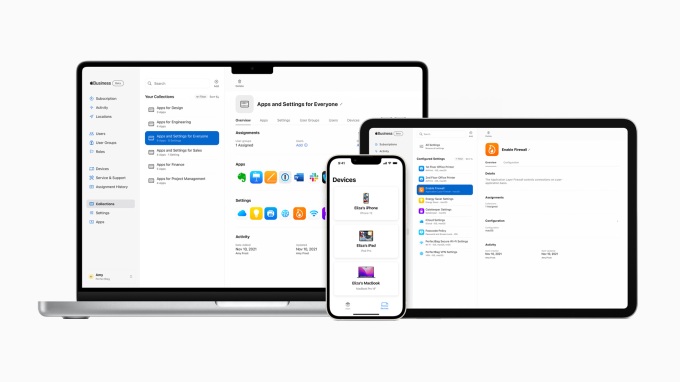For many small businesses, trying to manage their employees’ Apple devices and keep them up-to-date is a huge challenge. These businesses tend to lack sophisticated IT departments, and when devices break down or users have questions, they are often left to figure out things on their own using Apple’s consumer support tools.
Recognizing this issue, Apple acquired Fleetsmith last year, and today the company announced the beta of a device management solution called Apple Business Essentials aimed squarely at businesses with less than 500 employees.
Susan Prescott, vice president of enterprise and education marketing at Apple, said that the company wanted to help these customers onboard, support and update employee Apple devices, then offboard them when workers leave the company.
“??It is designed to manage Apple devices across that lifecycle of the device and it’s comprised of three core pieces. It’s got device management, along with storage, as well as support in one single subscription,” Prescott explained.
The management component is composed of a combination of the Fleetsmith acquisition and the Apple Device Enrollment Program. It enables small businesses to have access to a similar set of tools as their larger counterparts, giving them more control over the devices and ensuring they work as soon as the employee logs in.
After a business signs up for the service, admins can create users and groups. Users belong to groups and admins can set up a configuration for each group that includes the number of supported devices and an amount of storage. Each company or group can also include a base set of apps that make sense for that group.

Image Credits: Apple
It’s worth noting that employees can bring their own devices, and when they sign in to a supported device, the company will set up a work profile for them. That way, only their work product is backed up, and should they leave the company, only their work will be deleted, leaving their personal stuff intact and out of the reach of the employer.
Regardless of whether it’s a personal or work-owned device, the solution also helps maintain security by keeping it up-to-date with the latest system updates. In addition, it enables admins to enforce security settings such as FileVault full-disk encryption on the Mac or Activation Lock to lock down any Apple device should it be lost or stolen.
The storage piece comes from iCloud, although companies are free to connect to a third-party storage provider like Dropbox. The support element will include help desk services for both the IT department running Apple Business Essentials and employees who have any Apple-related questions. That part will be handled through AppleCare+, Apple’s business-level support arm. Finally, when it launches out of beta, it will also include onsite service, whether in an office or at home, within four hours of reporting an incident. The latter will be run by Apple partners.
Maribel Lopez, founder and principal analyst at Lopez Research, said that it’s a service that should appeal to small businesses, essentially saving them from having to go through Apple consumer support channels, which aren’t really designed to meet business requirements.
“SMBs [have been] effectively left out of management and support. Many would’ve thought the heavier MDM (mobile device management) wasn’t for them, and The Genius Bar lacked the real-time support that every business, especially SMBs, needs. Fleetsmith was viewed as a more user-friendly, mobile-friendly way to think of [device] management, so that is part of it. User-centricity versus device-centricity is also a part of it,” she said.
Tom Mainelli, an analyst in IDC’s device and consumer research group, said that the new program gives small businesses access to a set of services that were previously only available to larger companies, and as long as the price is reasonable, chances are that they will be willing to pay Apple to provide these services.
“Apple’s focus on small businesses makes a great deal of sense. Enterprise customers likely already have management systems in place to manage their Apple products, but smaller companies don’t always have full-time IT. That means it can be tough for them to manage everything, especially when it’s a mix of employer-provided and employee-purchased devices,” he said.
“Apple will likely need to drive some education about what the various levels of service offered, and why a small business needs them, but I suspect many business owners will gladly pay Apple to take care of these challenges for them,” he said.
Although the service is free during beta, the company will charge on a per-user, per-month basis for the device management and storage components, based on the chosen configuration. There will be an additional per-user charge for the support pieces, although that won’t be ready until the solution is generally available, which is expected in spring next year.

